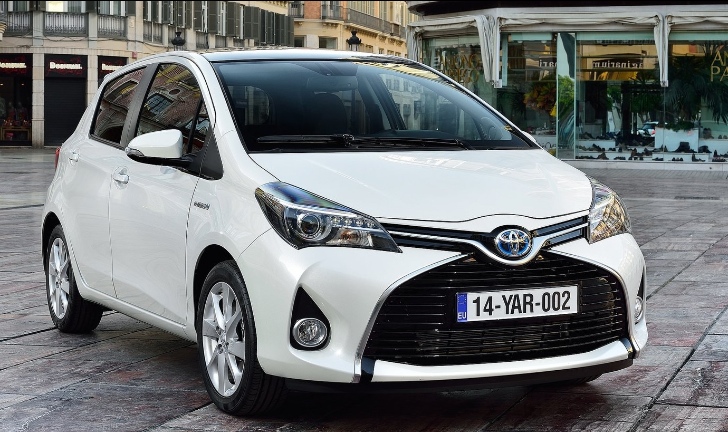Toyota recently announced it has not only increased its sales, but also registered better demand for hybrid models with its European customers. 12% of all Toyota sold in the old continent were Yaris, Auris, Prius or Verso hybrids and we have a sneaking suspicion that the Yaris facelift is the reason for the boom in sales.
You see, while it's nowhere near as technologically advanced as a Prius and feels crammed in comparison, the Yaris Hybrid is currently the only model we consider to be economically competitive. In some markets, low-spec models are as cheap as €15,000 but for the sake of our argument, we're sticking to Germany, where it costs from €17,300. For that kind of money, you get electric mirrors with integrated indicators, body colored handles, split folding rear seats, projector headlights and a massively impressive 7 airbags.
The 2015 model year has a sexy new look as well, combined with a familiar powertrain: 1.5-liter producing 100 horsepower. The standard gearbox is a CVT and performance is acceptable: 0 to 100 km/h in 11.8 seconds. But here's the big question:
Let's look at another new supermini with a diesel engine. For instance, the 2015 Skoda Fabia, which with a 3-cylinder 1.4 TDI diesel making 90 horsepower and a 5-speed manual achieves 4 l/100km in the city. However, the Fabia is cheaper by €1,360 at €15,940.
By our calculations, you would need roughly to travel 1300 hundreds of kilometers to make up the difference, based on the average cost of fuel in Germany right now. Yes, that's 130,000 kilometers, which is roughly the the whole life cycle of the car.
So what if you want a Ford? The most economical Fiesta is the bespoke ECOnetic model. This is equipped with a 1.6-liter TDCi making 95 horsepower. It boasts the same combined fuel consumption in the city as the Yaris Hybrid, but needs 3.7 l/100km in the city. The downside to its efficiency is that it costs €17,345, the same as the Toyota model, and doesn't look as good either.
The Ford Fiesta is currently the second best selling car in Europe with 38,516 deliveries in a month, but most of those come with the 1-liter EcoBoost turbo engine. Volkswagen's Polo is the third best seller and is available with the same 1.4 TDI engine as the Skoda Fabia. The downside is that it costs a whopping €18,025. So no matter how you look at it, the Yaris Hybrid makes more sense from a financial point of view.
However, this isn't the whole story. We have to talk about what the cars are really like. Diesel have a lot of torque, making them great highway companions. All the superminis we mentioned have a higher top speed than the Yaris and some people, especially keen drivers, prefer to have a manual over the CVT.
The upside of the hybrid's automated no-gear box is that almost anybody can drive it and get great economy, just as long as they understand the principles of hypermiling.
The 2015 model year has a sexy new look as well, combined with a familiar powertrain: 1.5-liter producing 100 horsepower. The standard gearbox is a CVT and performance is acceptable: 0 to 100 km/h in 11.8 seconds. But here's the big question:
How much money do you save with a hybrid? And shouldn't you buy a diesel instead?
On the combined cycle, the Yaris Hybrid claims 3.3 liters of fuel burned per 100 kilometers, which is what most diesels get. In that case, it's impossible to save any money, right? However, if you do most of your driving in the city, things begin to change. That's where the hybrids are kings, and the Yaris Hybrid actually gets the same fuel consumption in the city: 3.3 l/100km.Let's look at another new supermini with a diesel engine. For instance, the 2015 Skoda Fabia, which with a 3-cylinder 1.4 TDI diesel making 90 horsepower and a 5-speed manual achieves 4 l/100km in the city. However, the Fabia is cheaper by €1,360 at €15,940.
By our calculations, you would need roughly to travel 1300 hundreds of kilometers to make up the difference, based on the average cost of fuel in Germany right now. Yes, that's 130,000 kilometers, which is roughly the the whole life cycle of the car.
So what if you want a Ford? The most economical Fiesta is the bespoke ECOnetic model. This is equipped with a 1.6-liter TDCi making 95 horsepower. It boasts the same combined fuel consumption in the city as the Yaris Hybrid, but needs 3.7 l/100km in the city. The downside to its efficiency is that it costs €17,345, the same as the Toyota model, and doesn't look as good either.
The Ford Fiesta is currently the second best selling car in Europe with 38,516 deliveries in a month, but most of those come with the 1-liter EcoBoost turbo engine. Volkswagen's Polo is the third best seller and is available with the same 1.4 TDI engine as the Skoda Fabia. The downside is that it costs a whopping €18,025. So no matter how you look at it, the Yaris Hybrid makes more sense from a financial point of view.
However, this isn't the whole story. We have to talk about what the cars are really like. Diesel have a lot of torque, making them great highway companions. All the superminis we mentioned have a higher top speed than the Yaris and some people, especially keen drivers, prefer to have a manual over the CVT.
The upside of the hybrid's automated no-gear box is that almost anybody can drive it and get great economy, just as long as they understand the principles of hypermiling.

